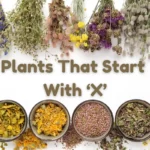There aren’t many flowers whose names start with the letter Q, but those that do typically contain the word “queen,” which suggests luxurious blossoms. Consider putting in these flowers that begin with the letter Q to give your outdoor space a regal feel. Let’s start scrolling while you get yourself a cup of tea and sit proudly.
Plant Lovers Rejoice: Discover the Top Q Plants in this Epic List

Every flower represents a soul reaching out to nature. Flowers are stunning to behold, and they resemble our souls as they open up to the beauty and sustenance of nature.
We choose to focus on stunning, fascinating, and amazing flowers that begin with Q in this article since we are flower enthusiasts.
Quaking Aspen (Populus Tremuloides)
A tree in the willow family is known as the quaking aspen (Populus tremuloides), so named because of how its leaves tremble in response to even the slightest breeze. Other names for the species are based on characteristics like its preferred habitat (mountain aspen), bark color (white aspen), or fall color (golden aspen).
It can be recognized by its uniformly smooth, light-colored bark that is sporadically punctured by darker knots and horizontal scars. Its flattened leafstalks, which make the leaves “quake” when the wind blows, are an even more distinctive characteristic. The leaves are 3 inches broad, rounded to slightly triangular, and coarsely serrated. A catkin is a flower or seedhead.
The quaking aspen is not the greatest tree for every landscape, but if you want to grow it, spring, after your region’s last frost date, is the best time to plant it. It expands by around 2 feet per year. In the western United States, it can live up to 150 years, with an average lifespan of roughly 60.
Queen Elizabeth Rose (Rosa Queen Elizabeth)
The first Grandiflora rose, which is a hybrid tea rose and floribunda rose, was named Queen Elizabeth. Grandiflora roses blend Floribunda roses’ numerous flower clusters with the tall, long, upright stems of hybrid tea roses. The Queen Elizabeth rose features glossy, dark green, almost leathery leaves, and pink flowers. It produces flowers repeatedly in the summer and early fall.
The cultivation of roses is known to be difficult and labor-intensive. Not this one, though—the Queen Elizabeth rose is a well-liked option, especially for rose beginners, because it’s robust, disease-resistant, and relatively simple to grow. It needs space, though, and is best placed towards the back because it is a shrub-like plant that grows to a height of 6 feet or more.
In order to give the roots time to develop and take hold before the plant goes into dormancy, Queen Elizabeth rose should be planted in the early to mid-fall. Select a planting area where the Queen Elizabeth rose will receive the full light and rich, well-worked, moist soil where it needs to thrive.
Even a variety like the Queen Elizabeth rose, which is regarded as disease-resistant, is not immune to the several illnesses that are infamous for roses. However, you may stop the spread of diseases by keeping up with routine pruning and ensuring sufficient air circulation by spacing plants at least 3 feet apart. After a rain or morning dew, pruning enables wet leaves to quickly dry out.
Quick Fire Hydrangea (Hydrangea Paniculata Bulk)
The Quick Fire hydrangea is a striking shrub with a number of exceptional qualities. In comparison to other cultivars of Hydrangea paniculata, it blooms about a month earlier, beginning in early to mid-summer and lasting through the summer and into the fall, depending on the local climate. The blooms start off being white, but as the season goes on, they gradually start to become pink and deepen in hue until they take on a reddish-purple or dark pink fall hue. Its fall foliage, which is deep orange to rust-colored, is another feature that sets it apart from other hydrangeas. Both humans and pets should avoid hydrangeas.
The plant grows vigorously and with an upright posture. It can be used as a specimen in perennial borders or planted in bulk plantings and groups as a screen or a hedge. The 6-inch panicles are suitable for dry or fresh arrangements because of their robust erect stems. The blossom color of Hydrangea paniculata cannot be modified by adjusting the soil pH, in contrast to bigleaf hydrangea (Hydrangea macrophylla).
The cultivar’s official trade name is Quick Fire. U.S. Plant Patents provide protection for the asexual propagation of the plant using vegetative material (cuttings).
One of the hardiest and simplest varieties of hydrangea to grow is Quick Fire. It is a wonderful option for urban settings because of its exceptional resistance to air pollution.
On new wood, or the woody stems that form during the current growing season, the shrub blooms. This offers two benefits. Because there are none on the plant, not even a harsh winter can harm the buds. It also means that you can put off pruning the woody growth until the first few weeks of spring without ruining the bloom.
Quinoa (Chenopodium Quinoa)
The main reason for growing quinoa (Chenopodium quinoa), a flowering plant in the amaranth family, is for its edible seeds. It comes from South America’s mountainous regions and has been produced for human consumption for countless years. Today, quinoa is farmed in more than 70 different nations. This historic superfood has a pleasant mild taste and is rich in vitamins and minerals. The seeds are frequently prepared like rice or milled into flour that can be used in baking and cookery as a gluten-free substitute.
Gardeners in chilly climates rejoice! The crop for you is quinoa. Quinoa plants are adapted to short days, chilly temperatures, lots of light, and dependably moist soil because they are native to the high-altitude slopes of the Andes Mountains.
Quinoa plants are unfortunately too big to grow in containers, but they are great additions to any existing vegetable or flower garden. Quinoa plants are generally low-maintenance, simple-to-grow plants.
Quinoa plants thrive in a sunny, bright environment with many hours of direct sunshine each day. However, it is advised to seek out some partial shade from the day’s heaviest heat. The optimal soil for quinoa plants is loamy, well-drained, and rich in organic content. Compost or fertilizer should be added to the soil prior to planting. When the seedlings are several inches tall, mulch the area around them to keep weeds out and moisture in.
Quesnelia (Quesnelia Quesneliana)
In the family Bromeliaceae, the genus Quesnelia contains roughly 20 species of flowering plants that are common in eastern and southeastern Brazil.
Winter is when the cone-shaped flowers blossom. M. Quesnel, a former consul in French Guiana, is the source of the name Quesnelia.
Once they are planted, quesnelia don’t need your whole attention because they are simple to grow and little maintenance.
They stand for tenacity and toughness as well. The flowers love moist, well-drained soil and are typically blue, red, pink, and yellow in color.
As indicated, they demand full or partial light, average water needs, and little upkeep.
Quince Flower (Chaenomeless Speciosa)
Regarded as the lone member of the Rosaceae family’s Cydonia genus; also known as Japonica. It is well-known for its pears and fruit that resemble apples and can be used to make jams and jellies as well as being a source of nourishment.
Any area with well-drained soil, full sun, medium sun, or light shade is suitable for growing quince. In the winter and spring, they flower.
White, pink, or crimson blooms can be found. They can withstand heat, drought, and both sun and shade, although sunshine is necessary for them to produce big blossoms and ripe fruits. It doesn’t need much upkeep, much like a Quesnelia.
Join 25,000+ smart readers—don’t miss out!








